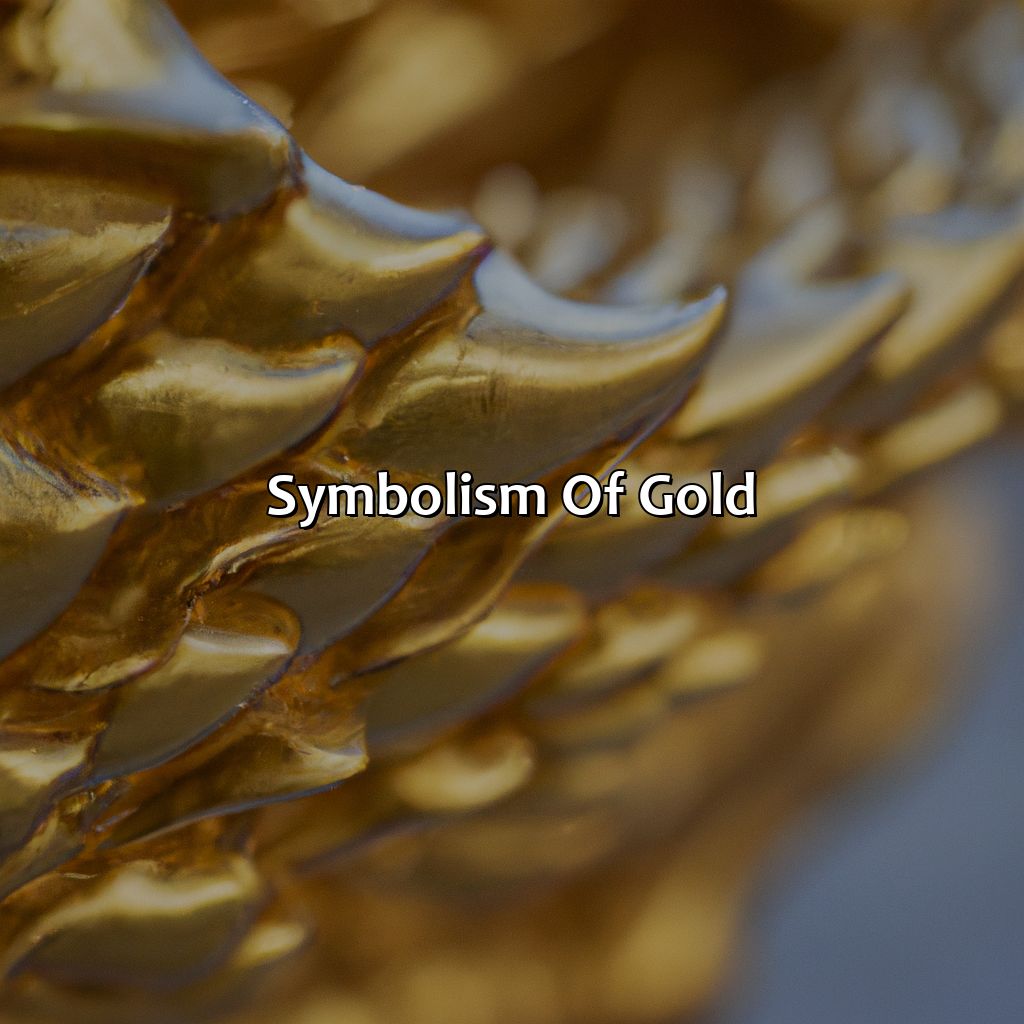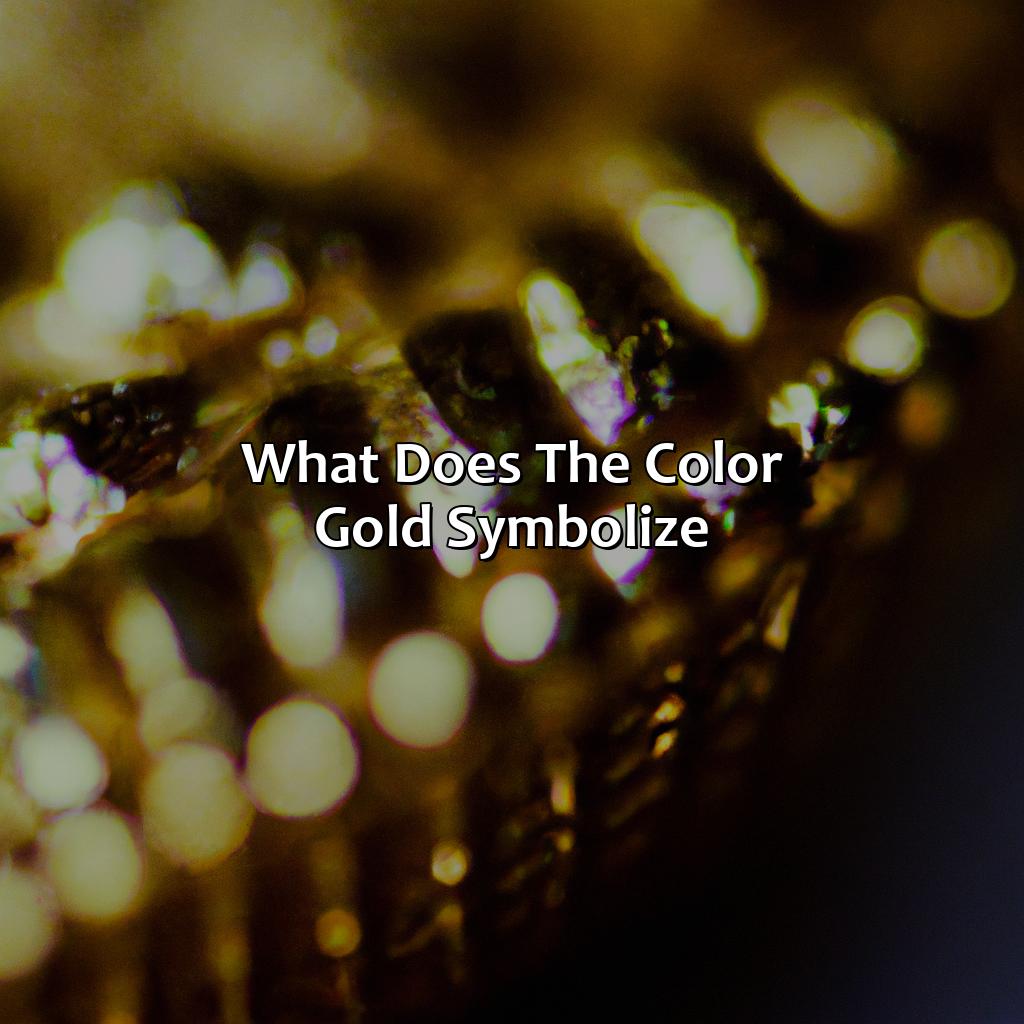Key Takeaway:
- Gold is a highly revered and valued color symbolizing wealth and prosperity. It has been an important part of human culture for centuries, and its significance and symbolism vary across cultures and religions.
- One of the main symbolic meanings of gold is its association with wealth and prosperity. Gold has been used as a status symbol throughout history, and is often seen as a representation of luxury and opulence.
- Gold is also associated with success and achievement, as seen in the symbolism of gold coins, gold medals, and gold trophies. Additionally, gold is linked with wisdom and intelligence, as represented in the symbolism of the golden ratio and other golden objects.
Understanding the Color Gold

Photo Credits: colorscombo.com by Nathan Lopez
Are you ready to explore gold? Let’s dive into what it means and its rich history and cultural significance. We’ll look at the definition of gold, its symbolism in mythology, and its great importance in alchemy. Get ready to uncover the true essence of this highly valued color!
Definition of Gold
Gold is a precious metal that is highly valued for its unique and exceptional properties. It is an element that has a symbol ‘Au’ with atomic number 79.
Gold has been used by humans for over 6,000 years due to its rarity, durability, and beauty. It is also one of the most valuable natural resources in the world and holds significant importance in various cultures across the globe.
The color gold represents wealth, prosperity, and success because of its association with the precious metal of the same name. This symbolism has existed for centuries and continues to hold significance today. Additionally, gold signifies wisdom, intelligence, luxury, opulence, spirituality and illumination.
Raw gold symbolism plays a vital role in different fields such as fashion and jewelry where it is used to create exquisite pieces of art. Moreover, it is utilized in architecture and interior design to add a touch of elegance to buildings or homes. In literature and art, gold often represents royalty or divine authority. Sports trophies are often made from gold to represent excellence and achievement.
Historically speaking, ancient Egyptians believed that gold had spiritual significance which was embodied by their beloved gods. Gold was also used as currency by some countries during early civilization because it represented wealth in those times.
From the mythical touch of King Midas to the mystical alchemy of medieval times, gold has been a coveted symbol of power and transformation.
History and Culture of Gold
Gold has been deeply intertwined in the cultural and historical fabric of civilization for ages. The precious metal’s significance can be traced back to ancient times when it was regarded as a symbol of wealth and power. Gold in mythology and its aurum symbolism further enhanced its importance. The Egyptians believed that gold was the skin of their gods while the Incas considered it as the sweat of their Sun God, Inti. Gold had even greater alchemical significance as it represented the transformational process from base metal to enlightenment.
The culture surrounding gold varies across different civilizations and regions. In China, gold symbolizes luck and prosperity while in India, the metal is associated with divinity and purity. In Ancient Rome, victorious generals were draped in golden wreaths as a mark of ultimate triumph.
Despite being universally regarded as valuable, there have been instances where civilizations have lost their affinity towards gold due to various reasons such as economic instability or societal changes. However, its allure remains unscathed due to its timeless appeal.
As seen from its rich past and diverse cultural connotations, gold is more than just a precious metal; it is an embodiment of wealth, artistry, and spirituality that transcends boundaries of time and space. It is not surprising that the association between gold and humans continues till this day with continued popularity seen across fashion trends, architectural designs, art forms, sports medals among others; highlighting just how integral gold is in our society. As we evolve as a civilization so will our affinity towards this revered metal grow with every passing day leaving us not wanting to miss out on all it has to offer both aesthetically and metaphorically speaking.
Gold has been treasured not only for its material worth, but also for its spiritual significance in various religions and as a symbol of illumination.
Symbolism of Gold

Photo Credits: colorscombo.com by Joseph Wright
Gain insight into the symbolism of gold and its role in religions, spirituality, and literature. Learn how gold symbolizes wealth, prosperity, success, and achievement. Discover the representation of knowledge and wisdom through golden objects. Appreciate lavishly gilded art, the ethereal qualities of gold, and the symbolism of golden hour and light.
Wealth and Prosperity
The color gold has long been associated with wealth and prosperity. Its symbolism as a status symbol dates back centuries, with gold being a precious metal as coveted today as it was in ancient times. The luminous appearance of gold represents the illumination that wealth and abundance can bring to one’s life.
More than just a material possession, the symbolism of gold transcends monetary value and enters into the realm of aspiration and achievement. Gold can also represent success in both professional and personal pursuits, signifying accomplishment and prestige.
Gold as a status symbol is intertwined with its precious metal symbolism. It’s no surprise that gold has played an integral role in trade and commerce throughout human history. This valuable resource has been used to signify power, position, and influence among different cultures, still seen in modern-day luxury brands.
Pro Tip: Incorporating touches of gold into your wardrobe or interior design can add a touch of richness or opulence to your surroundings or attire.
Gold coins may buy you success, but a gold medal or trophy is more likely to bring you achievement.
Success and Achievement
The color gold is a symbol of achievement and success. It represents the pinnacle of attainment in one’s life, career or field. Gold coins symbolism is common in cultures worldwide as it represents financial prosperity that one may achieve through hard work. The gold medal symbolism holds great significance, especially in sports, where they are awarded to athletes for their remarkable performance in a competition. Similarly, the gold trophy symbolism is another form of recognition given to people for achieving excellence. It is often seen in competitive fields such as art, music, and even business.
In literature and art, gold is used to symbolize success and accomplishment. In many ancient paintings and artifacts, leaders are often depicted wearing clothes adorned with gold materials implying power and leadership. Many luxury brands use the color gold in their designs to signify high-quality products representing success.
Some pro tips include that when giving gifts or awards for achievement or success, choosing items made from gold material could be a great option as a subtle nod to its symbolic value. Additionally, using the color gold in decorations and branding could also add to the aesthetic beauty while leaving an indirect impression of success on customers or guests’ minds without being too overt about it.
Unlock the secrets of the universe with the golden ratio symbolism and meanings behind golden objects.
Wisdom and Intelligence
The significance of gold in representing wisdom and intelligence can be traced back to ancient times. It is associated with the qualities of enlightenment and knowledge, reflecting the importance placed on these characteristics within various cultures. In terms of symbols, gold is often used in conjunction with the golden ratio symbolism to represent mathematical precision and order.
Golden objects and their meanings further reinforce this association. The use of gold medals in academia, for instance, signifies mastery of a specific discipline or field of study. Ancient philosophical teachings also uphold its value as a representation of illumination and higher understanding.
One unique detail worth noting is that the color’s association with intellect feeds into its use in contemporary branding and marketing strategies. Companies that want to convey high levels of sophistication or intelligence may include gold coloring in their logos or product packaging.
According to “Psychology & Marketing” by Brian Loomes, research has shown that brands using golden hues are perceived as more exclusive than those that do not.
Source: https://onlinelibrary.wiley.com/doi/full/10.1002/mar.20730
From gilded art to literary symbolism, gold is the ultimate language of luxury and opulence.
Luxury and Opulence
Gold brings to mind an image of Luxury and Opulence, reflecting the grandeur and extravagance associated with the metal’s rarity. Gold has played a significant role in securing status, and its exclusivity has made it a material of choice for royalty and the wealthy throughout history. Gold remains one of the most expensive materials used in fashion, jewelry, architecture, interior design, literature, sports and awards.
Gilded art is a classic example of how gold carries symbolic meanings beyond its materiality. In art, gold represents not only wealth but also divinity, purity and enlightenment. The gilding technique was used widely in medieval church art to emphasize holiness and divinity.
In literature, writers often use gold as a symbol of the ultimate reward or prize for their protagonists’ hard work or perseverance. Be it hidden treasures or mythical objects, gold is frequently used as a metaphor for success beyond measure.
To tap into the symbolic significance of gold in your creative work or branding efforts consider associating yourself with historical connotations around opulence rather than just using the phrase “luxury”. Similarly, exploring gold symbolism further can be useful for literary analysis to extract deeper meanings from texts that use this valuable metal as a theme.
Therefore if you’re designing an ad campaign centered on luxurious products ranging from bridal wears to interior decor items; highlighting that affluent aura that accompanies gilded art will definitely amplify your brand’s posh appeal.
Get ready to bask in the glow of spirituality and illumination with the symbolism of golden hour and golden light.
Spirituality and Illumination
The Color Gold’s significance in spirituality and illumination: The symbolism of the color gold extends far beyond material riches. Its golden hour symbolism, specifically, is often used to represent divinity, enlightenment, and higher knowledge. Similarly, golden light symbolism is associated with spiritual awakening or enlightenment experiences. From religious icons decked in golden robes to gilded manuscripts adorned with illuminations to the halo of saints and holy figures, gold has long been intertwined with transcendence.
In various ancient cultures and religions, gold was considered a divine metal that represented the Sun God or other deities. It was also believed that drinking gold could confer immortality upon an individual. In Christian philosophy, the use of gold suggests an emphasis on spiritual values over material wealth. Moreover, in Hinduism and Buddhism, it signifies the attainment of higher knowledge and wisdom.
In traditional Chinese medicine, when taken orally in small doses for extended periods of time, tiny amounts of metallic minerals like gold are said to have positive effects on psychological health by enhancing holistic metabolic balance in our mind and body system.
Interestingly enough, Emma Goldman said: “No one has yet fully realized the wealth of sympathy, kindness and generosity hidden in the soul of a child…The effort of every true education should be to unlock that treasure.” Gold is the ultimate accessory in fashion and jewelry – because nobody ever said no to a little extra bling.
Significance of Gold in Different Fields

Photo Credits: colorscombo.com by Gregory Moore
Gaining an understanding of gold’s importance in multiple aspects, such as fashion, jewelry, architecture, literature, art, sports, and awards, requires a deep dive into its symbolic meanings. To help you out, the following sub-sections will give a brief summary of gold’s different usages and their meanings. For example, golden dome symbolism, gold standard symbolism, and gold symbolism in art.
Fashion and Jewelry
Gold jewelry has always been an emblem of status and elegance. This shines true even in modern fashion trends. The symbolic meaning of gold jewelry is to show a person’s wealth, success, and opulence.
The luxurious quality of gold jewelry has made it a must-have item in many cultures around the world. The use of gold jewelry in traditional attire can often be seen reflecting their historical relevance and association with wealth.
The incorporation of gold jewelry into contemporary fashion attires can be traced back to the ancient Egyptians’ period. They considered gold as God’s skin, which was thereby associated with religious beliefs. Later on, Greek civilization popularized the use of Goldsmiths and the use of molds for making intricate designs on jewelry pieces.
Symbolic meaning of gold jewelry also includes its significance as a gift for special occasions like weddings, anniversaries, and graduations.
A true fact: According to Business Insider (source), during the recession in 2008 to 2010, when the global economy slowed down, one market that remained strong was that of fine quality Jewelry as people invested more in tangible assets during times of economic uncertainty.
Golden architecture and interior design: Taking ‘bling’ to a whole new level with golden domes, harps, keys, and scales.
Architecture and Interior Design
The role of gold symbolism in architectural and interior design is significant. Gold is often used to create a luxurious atmosphere or to add opulence to a space. It can be seen in the detailing of ornate pillars, intricate crown moldings, and decorative trim work. The use of golden dome symbolism, golden harp symbolism, golden key symbolism and golden scales symbolism are common motifs used in both architecture and interior design.
Golden domes, for example, are often found in religious buildings such as mosques, churches, or synagogues. Their color represents the connection between heaven and earth. Golden harps are often used to represent music or a sense of harmony within a space. Golden keys symbolize access to knowledge and hidden mysteries, while golden scales denote justice and balance.
Additionally, gold finishes on furniture pieces such as frames, drawer handles or lighting fixtures can create a sense of grandeur within any space. Most importantly gold’s ability to reflect light makes it perfect for spaces where brightness is crucial.
A prominent example could be the Palace of Versailles in France where everything from the walls and ceilings to the furniture come alive with gilded details intricately woven throughout every inch of its grand halls. The palace serves as an inspiration till date for designers who wish to showcase luxury through decor primarily using gold accents.
Gold brings a whole new meaning to the phrase “art worth its weight in gold”.
Literature and Art
Gold Symbolism in Art has been present since ancient times, representing luxury, wealth, and prosperity. It is depicted in numerous art forms like paintings, sculptures and even illustrations that carry various cultural contexts. The use of gold in art speaks to the symbolic meaning it carries; it denotes supremacy, excellence and divine principles.
From medieval illuminated books to contemporary paintings, the use of gold to symbolize spiritual illumination is evident. In Christian iconography, such as Byzantine and Gothic art forms, saints are often clothed in gold garments or have halos made out of gold due to its association with holiness and purity.
Notably, Gustav Klimt’s “The Kiss”, which portrays a couple embracing amidst swirls of glittering gold leaf is celebrated for its representation of romantic love found within golden hues reflecting true passion and opulence.
It was during the Renaissance period where Gold symbolism in art reached its pinnacle as artists such as Michelangelo used it extensively as an important element signifying a religious message with deep meanings. According to William Morris’s golden-age style philosophy developed during the mid-19th century Art Nouveau movement; using golden hues are beneficial for promoting harmony between nature and people.
It is truly remarkable how Gold Symbolism in Art develops culture from time immemorial till today’s modern pieces. Winning a gold medal is the ultimate achievement in sports, but wearing a golden crown is reserved for true royalty.
Sports and Awards
The use of gold standard symbolism plays an essential role in determining winners while symbolizing excellence and achievement. The following are some examples of how gold is used in sports and recognition ceremonies:
- Gold medals are awarded to winners of first place, demonstrating excellence in their field.
- Golden trophies are frequently given out during championship matches or competitions.
- The Golden Boot award is presented to the top scorer in a football league.
- Athletes who break world records or achieve outstanding feats are often rewarded with a golden medal.
- The Heisman Trophy, one of college football’s most prestigious awards, features a statue made entirely of gold-toned brass.
- In many Olympic Games ceremonies, athletes who place first receive the highest honor of standing atop a podium draped with a golden cloth.
It is worth noting that these sports and awards hold cultural significance around the world. For example, receiving a golden crown from winning Miss Universe signifies the epitome of beauty and grace.
Pro Tip: When giving recognition or awards, incorporating gold symbolism can add prestige and value to the achievement being recognized.
Five Facts About What Gold Symbolizes:
- ✅ Gold symbolizes wealth and prosperity in many cultures. (Source: The Spruce)
- ✅ It is also associated with luxury, glamour, and extravagance. (Source: Color Wheel Pro)
- ✅ In many religions, gold is seen as a symbol of spirituality and divine wisdom. (Source: World Gold Council)
- ✅ Gold is often used to commemorate special occasions, such as weddings, anniversaries, and religious holidays. (Source: The Knot)
- ✅ The symbolism of gold can vary from culture to culture, with some seeing it as a symbol of purity and perfection, while others associate it with power and authority. (Source: Live Science)
FAQs about What Does The Color Gold Symbolize
What does the color gold symbolize?
The color gold is often associated with wealth, prosperity, and success. It also represents luxury, wisdom, and enlightenment.
What is the cultural significance of gold?
Gold has been highly valued in many cultures throughout history. In ancient Egypt, it was believed to be the skin of the gods and was used to decorate temples and tombs. It was also used as currency and as a symbol of power and wealth.
What emotions are associated with the color gold?
The color gold is often associated with feelings of optimism, happiness, and warmth. It can also represent a sense of accomplishment and pride.
What does the color gold symbolize in art?
In art, gold is often used to represent richness, opulence, and extravagance. It can be used to emphasize important elements or to create a sense of grandeur.
What does the color gold symbolize in spirituality?
Gold is often associated with the divine and is often used in religious rituals and ceremonies. It represents enlightenment, wisdom, and spiritual awakening.
What are some common associations with the color gold?
Some common associations with the color gold include success, achievement, sophistication, and refinement. It is also often associated with the sun and with royalty.






